The Crucial Role of PFDs in Kitesurfing Safety
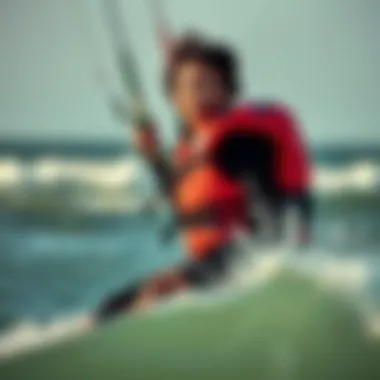
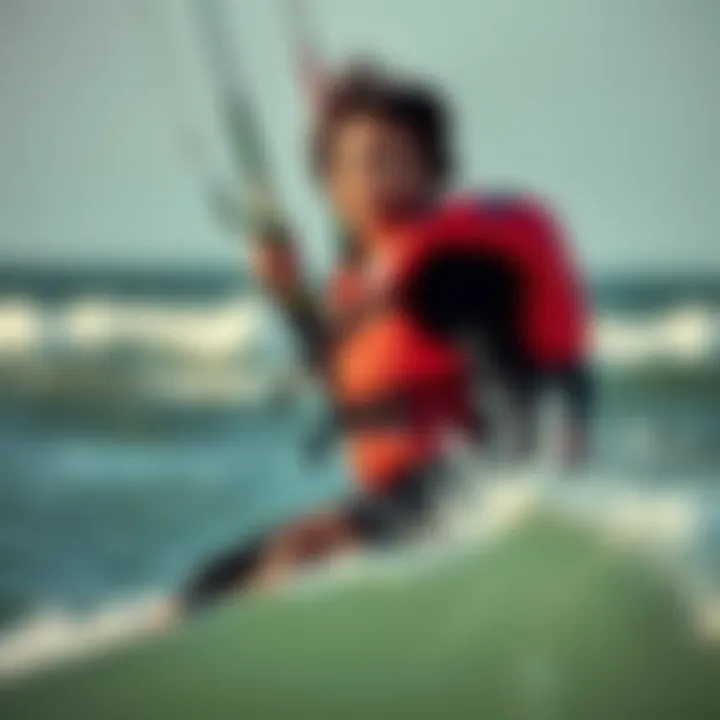
Intro
Kitesurfing is more than just a thrill-seeking adventure; it's a dance between man and nature. However, as exhilarating as it can be, the sport also comes with inherent risks. One pivotal way to mitigate those dangers is by utilizing personal flotation devices, or PFDs. While many riders may view these devices as just another piece of gear, their significance cannot be overstated. They not only enhance safety but also allow kitesurfers to push their limits with greater confidence.
In this article, we will delve into the various aspects of personal flotation devices, exploring their types, features, and how to choose the right one for you. By understanding the critical role these devices play, both novices and seasoned veterans can better appreciate the importance of safety on the water. Ultimately, this piece serves to equip kitesurfers with the knowledge they need to make informed decisions about their safety gear, ensuring that every ride is both exciting and secure.
Gear and Equipment
When it comes to kitesurfing, having the right gear is essential not just for performance but also for safety. Personal flotation devices are a key component of this gear. In this section, we’ll break down the various levels of equipment that address both safety and riding efficiently.
Essential Kiteboarding Gear for Beginners
- Personal Flotation Devices: For newcomers, it’s vital to invest in a quality PFD that fits well and is suited for kiteboarding. Look for options that are designed specifically for water sports to ensure freedom of movement while still providing buoyancy.
- Kite and Board: Beginners typically need a kite and board that match their weight and skill level. Generally, a smaller kite offers a better learning curve but always consult with experienced riders or instructors for personalized advice.
- Harness: The harness plays a crucial role in connecting the rider to the kite. A comfortable harness helps in leveraging the kite's pull while minimizing strain on the arms.
Advanced Equipment for Experienced Riders
- High-Performance PFDs: As skills progress, some riders opt for more advanced PFDs that feature inflation systems. Such devices provide an added layer of security and can be crucial in challenging conditions.
- Specialized Kiteboards: Experienced riders often invest in boards tailored for specific styles such as freestyle or wave riding. The right board can significantly impact performance.
- Wetsuits: Depending on local conditions, a wetsuit can serve as insulation against cold water and also add buoyancy.
With the right gear, including a suitable PFD, kitesurfers can navigate challenging waters while ensuring their safety. Always remember that as thrilling as the sport may be, preparation and equipment play a critical role in riding success.
"Safety isn't just a rule; it's the foundation of every great ride."
Make sure to consider these elements and invest in gear that complements your skills and heightens the overall experience.
Understanding Kitesurfing
Kitesurfing is more than just a sport; it’s a captivating blend of skill, strength, and a profound connection to the elements. To truly appreciate the significance of personal flotation devices (PFDs) in this exhilarating activity, one must first grasp the essence of what kitesurfing entails. From the gentle breeze on your face to the thrilling moments of soaring across the water, understanding the fundamentals of kitesurfing sets the stage for recognizing safety protocols.
Kitesurfing involves riding on a small board while being propelled by a large kite. The kite, controlled by a harness and lines, enables riders to harness wind power. This simple premise brings about complex dynamics, where wind patterns, water conditions, and rider skill all intertwine. Factors like these underscore the need for preparedness, both in skill and safety equipment.
Definition and Overview
In essence, kitesurfing is an aquatic sport combining aspects of surfing, wakeboarding, and paragliding. The rider stands on a board attached to a power kite, which is flown in the wind. Riders use the kite's pull to gain speed and perform tricks or navigate through waves. Just as a sailor wouldn’t venture out without checking their boat, kitesurfers need to ensure they’re equipped with the right safety gear, including PFDs, to ensure a safe experience on the water.
One cannot overlook the thrill of kitesurfing; it is invigorating. However, without proper safety measures, the same thrill can turn into treacherous situations rather quickly. The wind can shift, waves can rise, and accidents may happen, often without warning. This reality is why understanding kitesurfing goes hand-in-hand with comprehending the use of PFDs.
"Be prepared; anything can happen out there. Safety isn’t just smart; it's essential."
History of Kitesurfing
The roots of kitesurfing can be traced back to ancient practices involving kites for transportation across water. In modern times, however, the sport took shape in the late 20th century. It evolved as windsurfing enthusiasts began experimenting with kites for propulsion. During the 1980s, pioneers like Pedro H. L. D. B. and others made notable advances in kite design, leading to the emergence of kitesurfing as we know it today.
By the 1990s, kitesurfing exploded in popularity with improved equipment designs and safety features. This increase in participation brought with it heightened awareness regarding safety measures. Consequently, the importance of wearing PFDs became more pronounced as kitesurfers recognized that, while the sport could be thrilling, it also involved inherent risks.
Over the years, the sport grew across various landscapes, with its community constantly evolving. Each kitesurfing locale, whether it’s the breezy beaches of Brazil or the flat waters of the Caribbean, brings unique challenges and experiences, reinforcing the importance of keeping safety at the forefront. Understanding kitesurfing, therefore, requires a historical lens that appreciates both its evolution and its continuous commitment to rider safety.
The Role of Safety in Kitesurfing
Kitesurfing offers a thrilling dance with wind and water, yet it drapes a significant responsibility onto participants. Understanding the role of safety in this sport isn’t just an add-on; it's a cornerstone. Kitesurfers need to embrace safety gear to navigate unexpected mishaps, and personal flotation devices (PFDs) are at the frontlines of that battle.
Importance of Safety Gear
Safety gear in kitesurfing goes beyond merely looking the part; it embodies preparation and awareness. Wearing appropriate safety gear can make the difference between a close call and a critical situation. Kitesurfers encounter various marine environments, and conditions can flip on a dime. Here’s why safety gear, especially PFDs, should be considerably prioritized:
- Breach of personal control: Winds can become unpredictable, and technical failures can impede control of the kite. Having a PFD guarantees that you remain buoyant and visible in water, allowing for potential assistance or self-rescue.
- Complex water dynamics: From choppy waves to sudden currents, water bodies pose unique risks. PFDs provide an essential buffer against the physicality of surf conditions, ensuring flotation and reducing weariness.
- Avoidance of injuries: A properly fitted safety vest can protect against minor injuries while performing maneuvers. Whether you find yourself crashing over the board or dealing with equipment mishaps, a PFD can absorb some of the shocks.
Moreover, certain types of PFDs even double as impact vests, offering more than just buoyancy but also cushioning for falls that can inevitably occur. In this world of thrill-seeking, safety gear offers a reassuring embrace that allows for fearless engagement with the elements.
Risks Involved in Kitesurfing
Kitesurfing, while exhilarating, isn’t without its fair share of hazards. Adventurers are often drawn to inline thrills, yet overlooking safety can escalate the risk dramatically. Many say that the ocean is a fickle friend, and that holds true in kitesurfing. Here are some of the primary risks faced in the sport:
- Equipment Failures: A broken line or malfunctioning kite can be perilous, leaving the kitesurfer vulnerable to the merciless elements. Ever heard of the phrase “what goes up must come down”? In kitesurfing, this can mean a fall into the water, so being prepared is essential.
- Weather Variability: Sudden storms or gusty winds can catch even the most experienced riders off-guard. It’s crucial to monitor the skies and be aware of changing conditions; knowing when to ride and when to retreat is a hallmark of a wise kitesurfer.
- Collision Risks: Various water users, from swimmers to boaters, create an unpredictable environment. Maintaining distance and awareness can prevent accidents, but the unfamiliar territory can sometimes breed complications.
In the vastness of the ocean, the consequences of neglecting safety can be severe, impacting not just the individual but also the community of kitesurfers.
No matter how seasoned you might be, understanding these risks ensures that you remain agile, both mentally and physically. Acknowledging these inherent dangers emphasizes the need for proper safety gear, particularly PFDs, which can pave the road to safer water escapades.
By integrating safety as a core tenet of kitesurfing, enthusiasts can relish the ride while keeping camaraderie with respect to the ocean’s whims. Safety is not just a checklist; it’s a vital companion on every kitesurfing journey.
What is a Personal Flotation Device?
Personal Flotation Devices, commonly known as PFDs, are vital tools used in water sports, especially in disciplines like kitesurfing. These devices are designed to keep you afloat in case of unexpected falls or emergencies while out on the water. Understanding what PFDs are and their significance in kitesurfing is critical for anyone who wants to engage in the sport safely. The proper use and selection of PFDs can mean the difference between a thrilling experience and a hazardous one.
Definition and Purpose
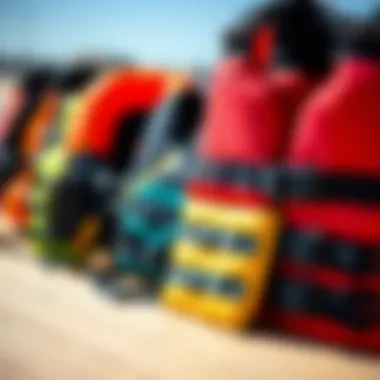
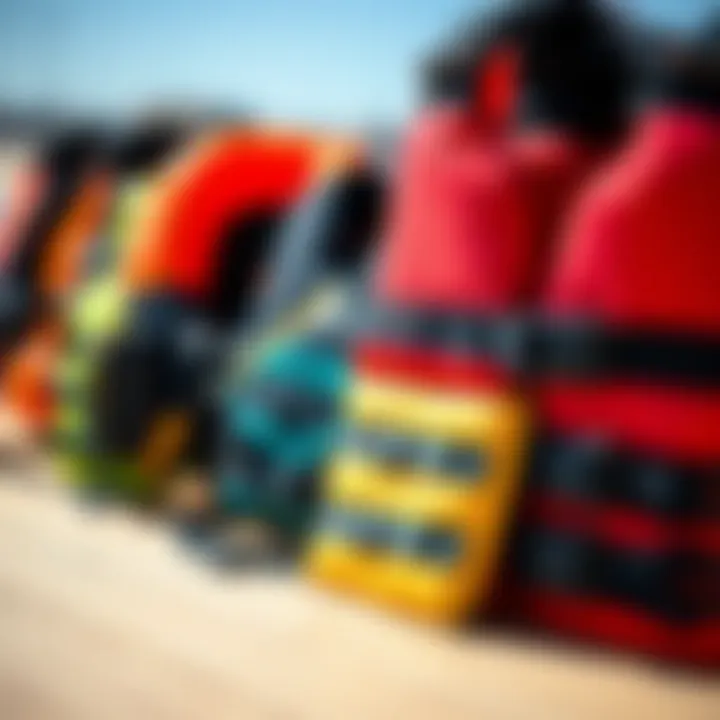
A Personal Flotation Device is any device designed to provide buoyancy in water. These can range from life jackets to buoyancy aids, each serving the purpose of ensuring safety by keeping an individual afloat. The primary function of a PFD is to reduce the risk of drowning. However, it also plays a role in enhancing confidence, allowing riders to focus on mastering techniques rather than worrying about their safety. In kitesurfing, accidents can happen in the blink of an eye, and having a PFD on can be a lifesaver.
Types of PFDs
The world of PFDs is diverse, offering various types suited to different circumstances and preferences. Each type has unique characteristics that make them suitable for different situations in kitesurfing. Here’s a closer look at the different types and their specific aspects:
Buoyancy Aids
Buoyancy aids are designed primarily for floating and are often slimmer than other types of PFDs. They provide flotation without overly restricting movement, making them a popular choice for kitesurfers looking for agility. Key characteristics include
- Lightweight Design: Allows for flexibility and ease of movement.
- Varying Buoyancy Levels: Depending on the rider’s skill and water conditions.
Though beneficial, buoyancy aids may have the downside of not offering any head support in deeper waters. Nonetheless, they encourage a sense of freedom and are favorable among experienced kitesurfers who often desire a product that keeps them agile yet secure on the water.
Impact Vests
Impact vests are primarily designed to protect against water impact during falls. They provide buoyancy as well as padding, reducing the risk of injury when crashing onto the surface. Notable points about impact vests include
- Enhanced Protection: The added cushioning helps absorb shocks.
- Secure Fit: Many are equipped with adjustable straps for a snug fit.
However, the bulkiness can sometimes hinder mobility. Even so, for those engaging in high-speed maneuvers, impact vests serve an essential role in ensuring safety against potential collision impacts, thus increasing overall confidence in performing tricks and jumps.
Inflatable PFDs
Inflatable PFDs offer a unique combination: they are compact when not in use but provide extensive flotation once activated. They typically contain a CO2 cartridge that inflates the device with the pull of a cord. Some of the highlights include
- Space-Saving Design: Great for storage during transport.
- Adjustable Buoyancy: Users can select when and how to inflate.
The downside is that reliability can be an issue if the mechanism fails. Despite these concerns, the appeal of inflatable PFDs lies in their unobtrusive nature while paddling; they don’t impede movement yet are ready to deploy when needed, making them an excellent option for kitesurfers who prefer a minimalistic philosophy without sacrificing safety.
Selecting the Right PFD for Kitesurfing
Selecting the right personal flotation device (PFD) for kitesurfing is crucial for an enhanced and safe experience on the water. Given the dynamic nature of the sport, where winds and waves can change in an instant, a well-chosen PFD can mean the difference between a close call and a serious accident. Understanding the specific features of a PFD that synergize with kitesurfing conditions helps riders to make informed decisions.
Factors to Consider
Fit and Comfort
When it comes to fit and comfort, getting it right is paramount. A properly fitted PFD allows you to move freely without constriction. If a PFD is too tight or too loose, it can hinder your performance or offer inadequate buoyancy. A snug fit will allow you to maintain your kitesurfing tricks without worrying about your gear shifting around. Moreover, certain PFDs come equipped with adjustable straps, which can enhance comfort by accommodating different body shapes.
For instance, some PFD models are designed with ergonomic shapes that follow your body's contours, thereby reducing chafing during long sessions on the water. This characteristic is not just a trivial feature; it significantly improves the overall riding experience.
Buoyancy Levels
Buoyancy levels are perhaps one of the most defining characteristics when selecting a PFD. Generally, kitesurfing requires a balance—too much buoyancy can restrict movement, while too little poses a drowning risk in harsh conditions. Newer kitesurfers might prefer PFDs with higher buoyancy to offer them more security while learning.
Many PFDs are designed to provide various buoyancy levels, making them versatile options for different skill levels. For instance, models with adjustable buoyancy chambers allow you to tailor the device according to your comfort and skill needs. However, a key disadvantage is that adjusting buoyancy in a last-minute scenario can be tricky, so it’s something to consider prior to hitting the water.
Mobility and Flexibility
Mobility and flexibility aren’t just fancy terms; they are essential for executing kitesurfing maneuvers. Riders need to have their upper bodies free to maintain balance, steer the kite, and control the board. A PFD that restricts arm movement can limit a rider's ability to paddle back to shore or correctly launch the kite.
PFDs designed with segmented panels or flexible fabrics improve freedom of movement, making them a popular choice among experienced riders. One unique feature of such PFDs is the ability to remain compact while still offering buoyancy. This blend ensures that as you ride the waves, your performance won’t be hampered by bulky gear. The downside might be that lighter, more flexible PFDs sometimes offer reduced impact protection, so striking a balance is key.
Brand Recommendations
When it comes to brands specializing in PFDs for kitesurfing, a few names stand out in the crowd:
- NRS is known for its durability and comfort.
- Mystic offers a wide range of stylish options with modern features.
- O'Neill is highly regarded for creating breathable models that are particularly suited for warm conditions as well as functionality.
By considering these elements collectively, kitesurfers can select a PFD that not only meets safety requirements but also enhances their overall experience on the water.
Best Practices for Using PFDs
In kitesurfing, safety goes hand in hand with enjoyment. Using personal flotation devices (PFDs) correctly can make a world of difference in emergencies. Therefore, understanding best practices for using PFDs is vital for every kitesurfer, whether you’re a rookie or seasoned pro. Well-fitted and appropriately maintained PFDs don’t just float your boat; they can save your life.
Proper Wearing Techniques
First things first, let’s talk about how to wear your PFD properly. Think of it this way: a PFD is only as good as it fits. If it’s slipping and sliding, it’s not going to do you any favors when you find yourself in a tricky situation. The key points for wearing your PFD include:
- Adjust Straps: Always adjust the straps to ensure a snug fit. You shouldn't feel like you’re wrapped in a straightjacket, but at the same time, it shouldn’t be loose enough to slip off in water. A good guideline is to ensure you can fit just a finger between your body and the vest.
- Wear It Over Layers: Depending on the weather, you might be wearing a wetsuit or other layers. Always put the PFD on top to ensure maximum buoyancy and easy accessibility.
- Don’t Skip the Check: Before hitting the water, do a quick check. Tug the vest to make sure it’s secure and test the buoyancy if possible.
"A little preparation goes a long way when it comes to safety in kitesurfing. Don't just toss the vest on and go; give it a few seconds of scrutiny."
Maintenance and Care
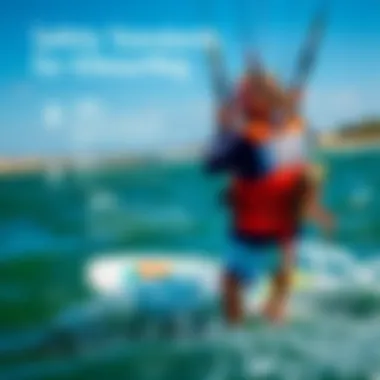
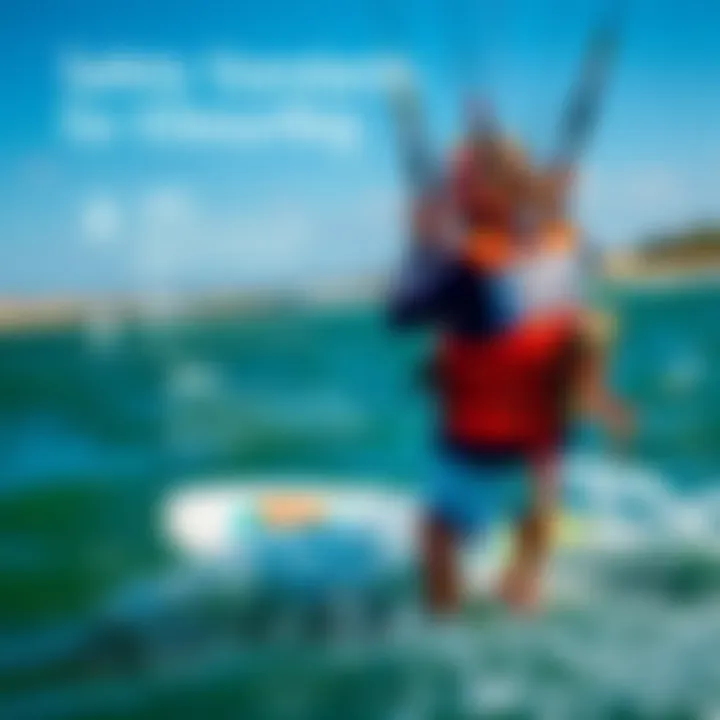
Taking care of your PFD is just as crucial as wearing it properly. A well-maintained PFD not only lasts longer; it provides better protection, especially during unexpected mishaps. To keep your PFD in tip-top shape:
- Rinse After Use: Whether you’ve been riding in salt water or fresh water, give your PFD a good rinse with fresh water immediately after use. This helps remove salt, dirt, and any other gunk that can degrade the fabric and buoyancy.
- Air Dry: Never put your PFD in direct sunlight for prolonged periods. This can break down the materials over time. Instead, let it air dry in a cool, shady place. It speeds up the drying process without harming the vest.
- Inspect for Damage: Before and after each use, check for rips, tears, or other signs of wear. If you spot anything concerning, see if it can be repaired, or consider replacing it. A compromised PFD is not worth the risk.
By adhering to these best practices, you ensure that your time on the water remains safe and enjoyable. The combination of proper wearing techniques alongside regular maintenance sets the stage for a positive kitesurfing experience, ultimately enhancing your confidence every time you hit the waves.
Kitesurfing Conditions and PFD Versatility
Kitesurfing is not merely a sport; it's a complex dance between man, machine, and nature. The conditions under which a kitesurfer operates can dictate everything—from the thrill of a breathtaking jump to the risk of a sudden plunge into the water. Personal flotation devices (PFDs) play a crucial role in how safely and effectively a rider can maneuver through these variable conditions. Understanding the interplay between PFDs and the diverse aspects of kitesurfing conditions provides insight into optimizing both safety and performance.
Adapting to Weather Conditions
Weather conditions can shift faster than the blink of an eye when out on the water. Winds can pick up, storms can roll in, and temperature fluctuations can alter the buoyancy of a rider's equipment. This is where the importance of adapting to these conditions comes in.
A stifling summer day with smooth winds feels vastly different from a chilly, gusty afternoon. Riders must consider their choice of PFD based on these elements.
- Warm Weather: Lighter, more breathable vests may enhance mobility while still providing the necessary buoyancy.
- Cold Weather: Heavier, insulated vests not only offer buoyancy but also protect from hypothermia, which can creep in during prolonged exposure.
- Gusty Conditions: Choosing a PFD that provides ample freedom of movement allows riders to react quickly to changing wind patterns.
Riders should inspect weather forecasts and consider bringing multiple PFD options to accommodate the day’s conditions.
Wave and Wind Impact on Safety
When it comes to safety in kitesurfing, waves and wind are two prominent players that can dramatically influence a rider's experience. A choppy sea can turn a leisurely ride into an intense challenge, while unpredictable winds can lead to accidents.
PFDs are indispensable in mitigating the risks posed by these factors. A well-fitted PFD helps ensure that riders remain afloat even in tumultuous waters. Below are key factors to consider about waves and wind:
- Waves: In larger swells, a PFD with higher buoyancy can prevent riders from being swept under. The stability offered by a flotation device is often the difference between safety and peril.
- Wind: In high winds, kitesurfers need to be able to maneuver smoothly and quickly. A PFD that minimizes bulk will support those sharp turns and fast-paced actions without hindrance.
- Tidal Currents: Rapid changes in tide can create unexpected currents, increasing the necessity for buoyancy. A reliable PFD ensures that riders have a safety net against being swept away.
"The right equipment is not just about style; it’s about survival. When conditions shift, so should your gear."
Additionally, understanding how waves and wind interact with each other can inform decisions about equipment before heading out. For instance, a choppy wave with high winds might require a design that emphasizes grip and stability, both in the board and the PFD.
In summary, kitesurfing conditions influence not just the thrill of the ride but also the fundamental aspects of safety. Being informed about how weather, waves, and wind can impact the experience ensures that every kitesurfer can enjoy this exhilarating sport while keeping safety at the forefront. Whether it’s adapting to variable weather or preparing for the unpredictable nature of waves and winds, the versatility of PFDs truly enhances the entire kitesurfing experience.
Education and Training
In the world of kitesurfing, education and training stand as indispensable pillars that bolster not just skill, but also safety. Riders, whether they are greenhorns or seasoned professionals, can tremendously benefit from structured learning. This isn’t just about mastering tricks or gliding across waves; it’s about ensuring that the adventure is rooted in safety. Having a solid grasp of safety protocols and receiving proper training can mean the difference between a thrilling day on the water and a catastrophic incident.
Learning Safety Protocols
Understanding safety protocols can't be overstated. Every kitesurfer, before even touching the water, should have solid knowledge about safety practices. It covers everything from understanding your personal flotation device (PFD) to knowing how to react in emergency situations. Here are some key aspects:
- Pre-launch checks: Ensure all gear, like lines and kites, is in good condition.
- Weather awareness: Riders must understand how wind conditions can alter their experience and affect safety. Often, a sunny day can shift quickly into a dangerous storm.
- Rescue techniques: Knowing how to assist fellow kitesurfers, or even yourself in distress, is crucial. For example, if someone gets separated from their board, understanding how to communicate effectively can save lives.
Riders should also familiarize themselves with how to manually inflate and deflate their PFD, should the need arise. All these protocols serve not only to protect the individual but also foster a sense of responsibility within the kitesurfing community.
Certifications and Courses
Certification programs and courses designed specifically for kitesurfing can be a valuable investment in one’s safety and proficiency. Many organizations provide structured learning paths that cover both practical and theoretical aspects of kite safety. A few noteworthy points about these programs include:
- Standardized training: Certification ensures that all participants learn the same fundamental skills and safety protocol, which raises the collective safety awareness within the sport.
- Refresher courses: For those who have been away from the sport for a while, refresher courses can help. They cover updates in safety regulations, new technology in equipment, and reinforce essential safety practices.
- Community building: Participating in courses creates a network of like-minded individuals who share the same passion for kitesurfing and safety, which can lead to valuable partnerships and conversations regarding best practices.
"Prioritizing education and training not only enhances individual skill level but deeply fosters a culture of safety within the kitesurfing community."
Most importantly, certification can sometimes be a requirement for accessing certain surfing locations or participating in competitions, further emphasizing its significance. Organizations like the International Kiteboarding Organization (IKO) offer certifications recognized globally. This empowers riders with knowledge and skills that transcend borders.
Overall, a strong commitment to education and training in kitesurfing isn't just about riding; it's about cultivating a conscientious and capable community. With proper understanding and application of safety protocols, many potential accidents can be avoided, making kitesurfing a fun and enjoyable activity for everyone involved.
Regulations and Standards for PFDs
Understanding the regulations and standards for personal flotation devices (PFDs) is like knowing the rules of the road before you hit the highway. For kitesurfers, this knowledge can mean the difference between a safe outing and a disastrous accident. Regulations provide a baseline for safety, ensuring that all riders—whether seasoned veterans or newcomers—are equipped with reliable safety gear. There’s no sugarcoating it; in a sport where the elements can change on a dime, solid safety measures are not just encouraged—they're essential.
Local Regulations for Kitesurfers
Local regulations regarding PFD usage vary widely from place to place. Some coastal areas have stringent rules that mandate specific types of flotation devices, while others may simply recommend them without enforcing strict compliance.
- Know Your Area: Before hitting the water, it's prudent to familiarize yourself with the local laws applicable to kitesurfing. For instance, states like California and Florida might mandate wearing a PFD certain conditions or offer guidelines for youth participants. Moreover, some beaches may have designated scores for kitesurfing, with regulations that differ across those areas.
- Consult Local Authorities: Engaging with local surf schools or kitesurfing communities can provide insight into current regulations. Websites like recreation.gov often have up-to-date information on laws regarding water sports in your area.
- Enforcement: Ignoring local regulations could result in fines and increased risk during emergencies. Police and park rangers often patrol popular kitesurfing spots, so having the correct gear is crucial not just for safety but to avoid potential legal issues.
In short, knowing these local regulations and adhering to them reflects good judgment and respect for the sport and those who enjoy it.
International Safety Standards
International safety standards offer a slightly broader umbrella, ensuring that the PFDs used across borders provide consistent levels of safety. These standards, often set by bodies such as the International Organization for Standardization (ISO), ensure quality and reliability in PFD design and functionality.
- ISO Compliance: A PFD that meets ISO standards means it has passed rigorous tests for buoyancy, durability, and performance in challenging conditions. When selecting gear, look for labels that indicate compliance with these international standards. This information can often be found on the labels of your device or in product descriptions.
- Global Recognition: A PFD that complies with international standards is recognized worldwide, which is essential for kitesurfers traveling abroad. For example, if you plan to kitesurf in Brazil, a PFD that meets ISO specifications will likely be accepted by local authorities and make for a smoother experience.
- International Rescue Protocols: Understanding how PFDs function within an international framework helps in grasping what to expect during an emergency. Different countries may have various procedures for handling maritime rescues, and knowing that your PFD meets international protocols can add another layer of confidence when out on the water.
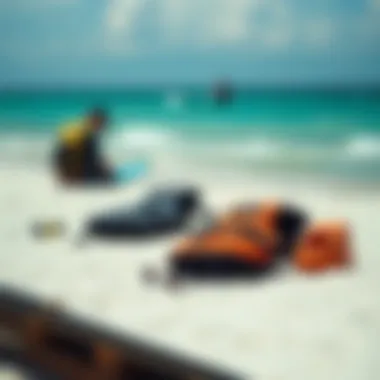
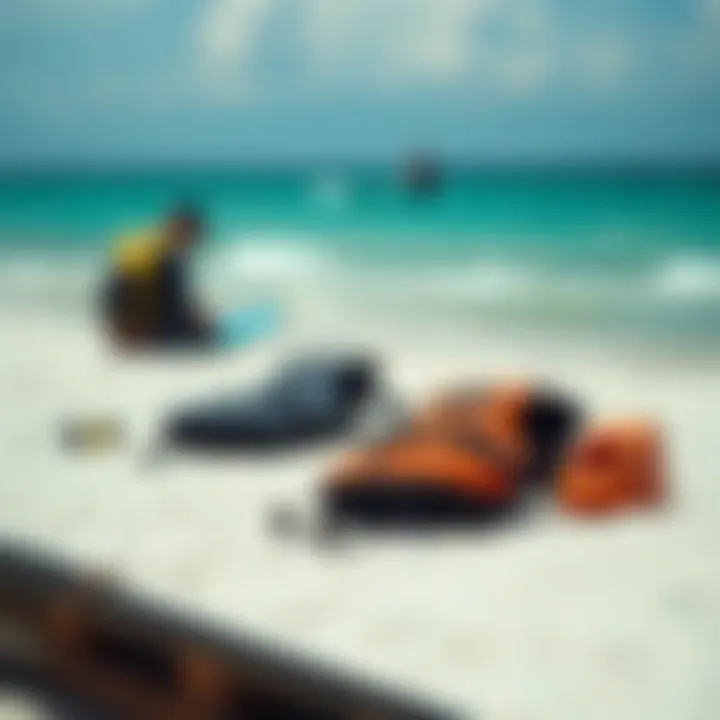
"Safety doesn’t have to be complicated, but it does need to be taken seriously. Understanding rules, both local and international, lays a solid foundation for an enjoyable kitesurfing experience."
A solid grasp of both local and international standards is just as vital as ensuring you have the right equipment. Doing your homework contributes to a collective culture of safety among all kitesurfers, making the sport not only safer but also more enjoyable for everyone.
PFDs and Emergency Situations
Personal flotation devices (PFDs) are not just accessories in kitesurfing; they are lifelines in turbulent waters. Understanding how to use PFDs during emergency situations can mean the difference between a close call and a tragic event. In a sport characterized by unpredictable winds and shifting tides, the potential for equipment failure or sudden accidents is always present.
Handling Equipment Failure
When kitesurfing, equipment failure is like a mechanical trickster, ready to play havoc with your day. A torn kite, a snapped line, or a malfunctioning harness can happen without warning, often leaving riders struggling in the water. In these moments, having a reliable PFD becomes crucial. Riders equipped with a properly fitting PFD can stay afloat, conserving energy while waiting for rescue or attempting to swim back to safety.
The buoyancy provided by a quality PFD allows one to maintain a stable position in the water, making it easier to signal for help. Open water can be disorienting, and the visibility that a bright-colored PFD offers can aid rescuers in locating you more quickly. It is essential to regularly check your gear to avoid surprises but remember that having a PFD won't eliminate risk; it creates an essential safety net.
"In the face of equipment failure, a PFD is not merely a precaution; it becomes your first line of defense."
Here are key considerations for handling equipment failure:
- Inspect Equipment Regularly: Before hitting the water, ensure your kite, lines, and harness are in good condition. A stitch in time saves nine.
- Understand Your Limits: Know when conditions are too hazardous to ride. Better to be safe than to be the one who goes missing.
- Wear Fitted PFDs: Ensure the PFD is snug but comfortable, allowing free movement while still keeping you buoyant.
Rescue Protocols
Rescue protocols are a fundamental part of kitesurfing safety. Should you find yourself in trouble, having a well-thought-out plan can work wonders. The first step is to remain calm; panicking leads to poor decisions. In situations where you cannot paddle or signal for help effectively, being in a PFD provides confidence that you will remain afloat.
When in distress, effective communication is key. If in a group, shout for assistance, as your friends may be nearby. If not, use your skills to signal your presence. Thumbs up or waving arms can alert potential rescuers to your situation.
Some critical steps to consider during rescue situations include:
- Establishing a Clear View: From atop your board, raise your arms to signal for help. Keep the PFD visible, especially if in a busy water area.
- Follow Buddy System: Always kite with someone when possible. Two pairs of eyes are better than one, especially if there is a problem.
- Use Personal Location Beacons: These devices can be a lifesaver if you end up in a more serious situation. They alert boats or lifeguards to your exact location.
The probability of accidents is reduced by being proactive—fitting your gear properly, practicing your rescue techniques, and communicating with others. A PFD is invaluable, acting as both a flotation device in emergencies and a reminder of the importance of safety in this dynamic sport.
By getting familiar with PFDs and emergency protocols, you can significantly enhance your kitesurfing experience while enjoying the thrill of the ride.
Community Insights and Experiences
The realm of kitesurfing is not only about the thrilling rush of catching waves and riding the wind but also encompasses the sharing of experiences and knowledge among its enthusiasts. Community insights and experiences are pivotal in understanding the role of Personal Flotation Devices (PFDs) in enhancing safety. These narratives can shine a light on real-world implications and lessons learned. Overall, peer-to-peer sharing fosters a sense of belonging and collective wisdom that is invaluable for both novices and seasoned riders alike.
Shared Safety Experiences
In the kitesurfing community, stories of near-misses or successful safety maneuvers are frequently exchanged in conversations. Such anecdotes are not just tales; they serve as lessons that reinforce the necessity of wearing PFDs. For example, a kitesurfer may share an incident where a sudden change in wind direction caught them off guard. They might explain how, despite the unexpected fall, their PFD provided much-needed buoyancy and support, allowing them to calmly reorient themselves and swim back to safety.
Moreover, these shared experiences can highlight the importance of specific features in PFDs. A rider might discuss how an inflatable PFD offers the freedom of movement needed for tricks while still being reliable in emergencies. Others might share insights on the differences between buoyancy aids and impact vests, emphasizing the importance of choosing the right type based on individual skill levels and local conditions.
Community stories about safety underscore the message that personal gear, specifically PFDs, is not merely an optional add-on. They highlight that every rider, regardless of their skill level, should prioritize safety by learning from those who’ve faced challenges on the water.
Peer Recommendations on PFDs
When it comes to selecting the right PFD, nothing beats the advice that comes from fellow kitesurfers who have been in the trenches, so to speak. Riders often bring their preferences to the table based on personal experiences with various brands and models. Recommendations are generally fueled by individual needs, as some may favor lightweight options for extreme agility, while others seek out robust PFDs that focus heavily on safety features.
Kitesurfing forums on platforms like Reddit often house vibrant discussions where users compare products, discussing the nuances between brands like Mystic, O'Neill, and Liquid Force. Some may assert that having a high visibility color on their PFD increases safety during low-light conditions. Others might even extend conversations into the realm of aesthetics, as personal style holds weight among lifestyle-driven sports.
As riders exchange their recommendations, they also underscore vital considerations, as some PFDs may enhance mobility while sacrificing buoyancy. This exchange helps guide others in making informed decisions focused on safety without compromising the enjoyment of the sport.
In essence, shared experiences and peer recommendations create a safety net of knowledge—continuing the cycle of learning that is vital for anyone engaging in kitesurfing. Fostering a collaborative environment leads to heightened awareness and a collective responsibility toward safety, firmly rooting the importance of PFDs in the consciousness of every kitesurfer.
The Future of PFDs in Kitesurfing
As kitesurfing continues to grow in popularity, the future of personal flotation devices is becoming increasingly critical. It’s not merely about keeping riders afloat; it’s about advancing safety, enhancing comfort, and integrating technology that supports the yearnings of today's kitesurfers. In an environment where the sea holds both beauty and unpredictability, the evolution of PFDs will play a crucial role in shaping the overall experience of the sport.
Advancements in Technology
The advent of technology is transforming many aspects of water sports, and kitesurfing is no exception. Relying on traditional buoyancy aids is likely to evolve as manufacturers begin to integrate smart technology into PFDs. This could include features such as:
- Integrated GPS Systems: Imagine a flotation device that not only keeps you afloat but also tracks your location and informs someone in case of any issues. An added layer of safety could vastly reduce risks when riding in remote areas.
- Automatic Inflation Systems: While inflatable PFDs exist, future designs may include sensors that automatically inflate the device upon contact with water. This ensures that riders do not have to fumble or struggle in an emergency.
- Wearable Technology Integration: With the rise of smartwatches and fitness trackers, future PFDs might be equipped to sync with these devices. Monitoring heart rate and other vital signs could provide riders with crucial data to assess their physical state while kitesurfing.
These advancements aim to create a PFD that is not just a safety requirement but a smart companion that enhances the kitesurfing adventure.
Sustainability Considerations
As environmental awareness peaks, the materials and methods used to manufacture PFDs are under scrutiny. More kitesurfers are beginning to recognize the importance of sustainability in their gear. The future of PFDs might see:
- Eco-Friendly Materials: Using biodegradable materials or recycled plastics can minimize the ecological footprint of PFD production. This shift would require innovation but is essential for aligning the kitesurfing community with global sustainability goals.
- Durability and Longevity: Future designs may emphasize creating PFDs that last longer, reducing waste over time. A PFD that can withstand the elements without significant wear and tear not only keeps riders safe but also contributes to a more sustainable option.
- Repairable Designs: Instead of tossing out a damaged PFD, systems that promote easy repairs could evolve. This could include modular designs where worn parts can be replaced rather than discarding the entire device.
In this pursuit of sustainability, manufacturers and riders alike can take a stand together, ensuring that kitesurfing remains a thrilling sport while safeguarding the environment.
"The future is not something we enter. The future is something we create."\
- Leonard I. Sweet
Merging technological advancements with sustainable practices can lead us to a bright future for PFDs in kitesurfing. This evolution will ultimately contribute to a safer, more enjoyable experience for all kitesurfers—ensuring that every ride remains thrilling while prioritizing safety and environmental responsibility.















